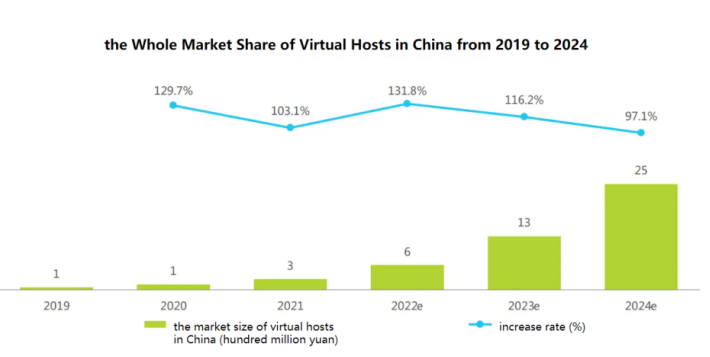The Explosive Growth of AI-Powered Virtual Hosts in E-Commerce in China
The application of AI-powered character in China.
by Azoya
In 2023, ChatGPT ignited the first fire within the global technology industry. Technology giants, including Microsoft, Google, Baidu, Alibaba, and ByteDance, all embraced generative AI, resulting in an exciting new industry growth driver. According to data from video-sharing site Bilibili, 230,000 virtual hosts broadcasted on the platform in 2022, a year-over-year (YoY) increase of 190%.
In fact, the launch of ChatGPT-like applications by many tech giants has made a huge difference in e-commerce in China. AI-powered virtual characters serve as a spokesperson or host in online shopping platforms, livestreaming events, or promotional videos. This article analyzes the application of AI-powered virtual characters in China.

Application of AI in e-commerce
AI has multiple applications to increase purchase conversion rates, improve shopping experiences, and predict consumer demand and feedback.
AI could work as a virtual assistant for consumers, recording and analyzing user behavior, preferences. Purchase history can be analyzed to provide personalized product recommendations, customized offers, and targeted advertisements. It enables brands to gain a deeper understanding of their customers and deliver personalized shopping experiences, resulting in higher exposure and conversion rates.
Augmented reality (AR) and virtual reality (VR) are trending among e-commerce customers. Estée Lauder navigated its “iMatch” virtual makeup service, allowing users simultaneously, on the basis of AI. The brand provides lipsticks, base makeup swatches, skin test technology for customers, and AR training classes for beauty advisors. This approach improves the efficiency of decision-making and the user experience, attracting tech-savvy beauty consumers.
F brands, AI can be employed to predict consumer demand, optimize inventory management, and enhance supply chain efficiency. The data collected or generated by AI contributes to ensuring product availability, effectively meeting customer demands and improving the turnover rate
Among these various applications, it is notable that AI-powered virtual characters have emerged as a compelling form of brand ambassadors. Businesses are investing in the design of visually-appealing images for advertisements, livestreams, and entertaining programs. This strategic approach gains traction among tech-savvy consumers who are drawn to cutting-edge innovations.
The use of anthropomorphic images leaves a strong impression on customers from the very first encounter, effectively imprinting the brand and its products in their minds. Triggered by subsequent interactions, these virtual characters evoke immediate associations and enhance brand recall. By incorporating virtual characters as brand ambassadors, businesses effectively leverage their captivating nature to engage with their audience and establish a strong presence in the market
Another form of virtual character is the 'virtual host,' which plays a crucial role in promoting and demonstrating products during livestreaming sales. With the significant surge in livestreaming in recent years, especially in China, there has been a dramatic increase in the demand for hosts, leading to high costs for human talent. Virtual hosts provide a solution to lower these costs. They are available 24/7 and can effectively leverage idle traffic, such as during late-night hours, to attract consumers. Moreover, virtual hosts can be personalized and customized according to specific audience segments, including language models tailored to different regions.
While virtual hosts offer cost efficiency, it's important to note their inherent lack of human touch and flexibility. Therefore, they are best utilized as complementary elements to human hosts, providing unique advantages in terms of efficiency, consistency, and customization. By combining the strengths of virtual and human hosts, businesses can optimize their livestream experiences and effectively engage their audience.
Giants use AI for a competitive advantage
Leading tech players, such as Alibaba, ByteDance, and Baidu, have made significant investments in digital humans. Ali Cloud, for example, offers an intelligent livestream room equipped with essential functions. It enables the automatic generation of livestream scripts and provides pre-set backgrounds to reduce preparation time. Ali Cloud also offers multi-module interaction, allowing digital humans to exhibit emotions, feelings, expressions, and gestures. The core of the service lies in the Software as a Service (SaaS) platform, which enhances operational efficiency, optimization, and review processes.
Alibaba has expanded its collaborations to include external digital humans as well. In a noteworthy instance during 2022, Alibaba partnered with the virtual character AYAYI to promote Chando non-fungible tokens (NFTs) on Tmall. This collaboration marked a significant milestone as it became the first Chinese domestic brand to launch NFTs on Tmall. By integrating virtual characters like AYAYI into its marketing initiatives, Alibaba continues to pioneer innovative approaches in the digital realm.

Following in the footsteps of Alibaba, ByteDance’s Huoshan Engine and Baidu have launched their own digital human solutions for livestreaming sales. It is highly likely that more companies will emerge and experiment in this industry as the demand for digital humans continues to grow.
Contrarily, livestreaming sales have yet to gain significant popularity in Western countries like the US, UK, and Canada. Influencers and consumers in these regions are not yet accustomed to the idea of making purchasing transactions during livestreams, although they are aware of advertisements within this medium. Western consumers tend to prioritize factors like product quality and performance over price alone when making purchasing decisions. Furthermore, they continue to enjoy offline shopping experiences as the digitization process has been slower in Western markets compared to China.
Nonetheless, with the expansion of cross-border e-commerce, experts anticipate this new business model will gradually be embraced in Western markets as well, given ongoing investments in livestreaming by retail leaders like Amazon and Walmart.
Douyin’s new regulation of AI generated content (AIGC)
In response to China's new regulation, the Administrative Provisions on Deep Synthesis for Internet Information Service, Douyin, the sister site of TikTok, recently introduced new rules regarding AI content. On May 9, the platform announced that creators would be required to label generative AI content to help viewers distinguish between virtual and real elements, and mitigate the spread of misinformation.
Furthermore, virtual hosts' accounts must undergo registration and real name authentication to prevent any unlawful use. The regulation also states that virtual hosts share the same responsibilities and obligations as human users, meaning they must adhere to all platform rules, including the prohibition of violent or sexual content. These measures aim to ensure a safer and more responsible environment for both virtual and human users on the platform.
What can brands do to capitalize on the trend of virtual hosts?
Creating a distinct virtual host requires designing and operating an intellectual property (IP) based on brand images. It's crucial to avoid monotonous characters, as the audience can easily grow tired of them. What truly sticks in their minds are the few characters that leave a lasting impression.
As evidenced by Douyin's data, the virtual anchor known as 'I don't eat for free' ("我是不白吃" in Chinese) achieved remarkable success, generating $122 million US in sales and attracting an audience of 1.09 million during a single livestream. This demonstrates that virtual characters possess similar or even superior promotional capabilities compared to human anchors. Leveraging these virtual characters for marketing purposes is becoming inevitable. For instance, the yellow character with big eyes and a friendly face can serve as a vivid reminder of Chinese cuisine, making it an effective tool for engaging consumers.
When designing a virtual host for your livestream, it's crucial to consider the characteristics and qualities that will deeply resonate with your target audience and effectively promote your products. Understanding your consumers is key to defining the host's persona and aligning it with the brand and products, with a particular emphasis on a pleasing appearance.
Additionally, from an intrinsic perspective, creating an engaging and relatable personality holds great significance. Virtual hosts should embody traits, such as friendliness, enthusiasm, confidence, charisma, and even humor. Striking a balance between professionalism and approachability can help establish trust and foster a genuine connection with your audience. By carefully crafting the persona of your virtual host, you can ensure they are relatable, appealing, and capable of effectively engaging your viewers during the livestream.
Incorporating both virtual and human hosts can prove to be a powerful strategy for optimizing the conversion rate and capitalizing on idle traffic during a livestream. During off-peak hours, leveraging virtual hosts is an ideal choice due to their cost-effectiveness and availability in guiding consumers to make purchases. In contrast, during peak hours when a large audience is tuning in, combining virtual and human hosts can generate significant traction.
A notable example is the collaboration between 'Lipstick King' Austin Li and the fan-designed VOCALOID Luo Tianyi during a livestream for L'Occitane. Despite encountering some technology issues that impacted the user experience, they successfully sold 10,000 product sets in just 30 minutes and became a trending topic on Chinese microblogging site Weibo. This success story highlights the immense potential of utilizing both virtual and human hosts to drive sales and capture public attention during livestreaming events.

Maintaining high-quality and diverse content during a livestream is essential to prevent audience aesthetic fatigue and reduce monotony. It is crucial to continually rotate among various themes, trends, or industry-related discussions to cater to different preferences and ensure the content remains fresh and engaging. By offering a variety of topics and perspectives, you can captivate a broader audience and keep them actively involved throughout the livestream. This approach not only mitigates the risk of similarity but also adds depth and excitement to the overall viewing experience.
It is crucial to closely monitor the development of virtual technology and continually enhance its personification and interaction. By remaining well-informed about the latest advancements and actively embracing them, you can create highly engaging and immersive livestream experiences that captivate your audience and differentiate your brand from competitors. Furthermore, consistently improving the personification and interaction within your livestreams helps to establish a strong connection with your audience and provide them with unforgettable experiences that leave a lasting impression.
Reference:
[1] https://pdf.dfcfw.com/pdf/H3_AP202210141579159128_1.pdf?1665767294000.pdf
[2] https://m.yubaibai.com.cn/article/5606808.html
[3] https://socialone.com.cn/loccitane-mindshare-case-may-2020/
[5] https://www.perfectcorp.cn/zh-cn/business/successstory/detail/42
